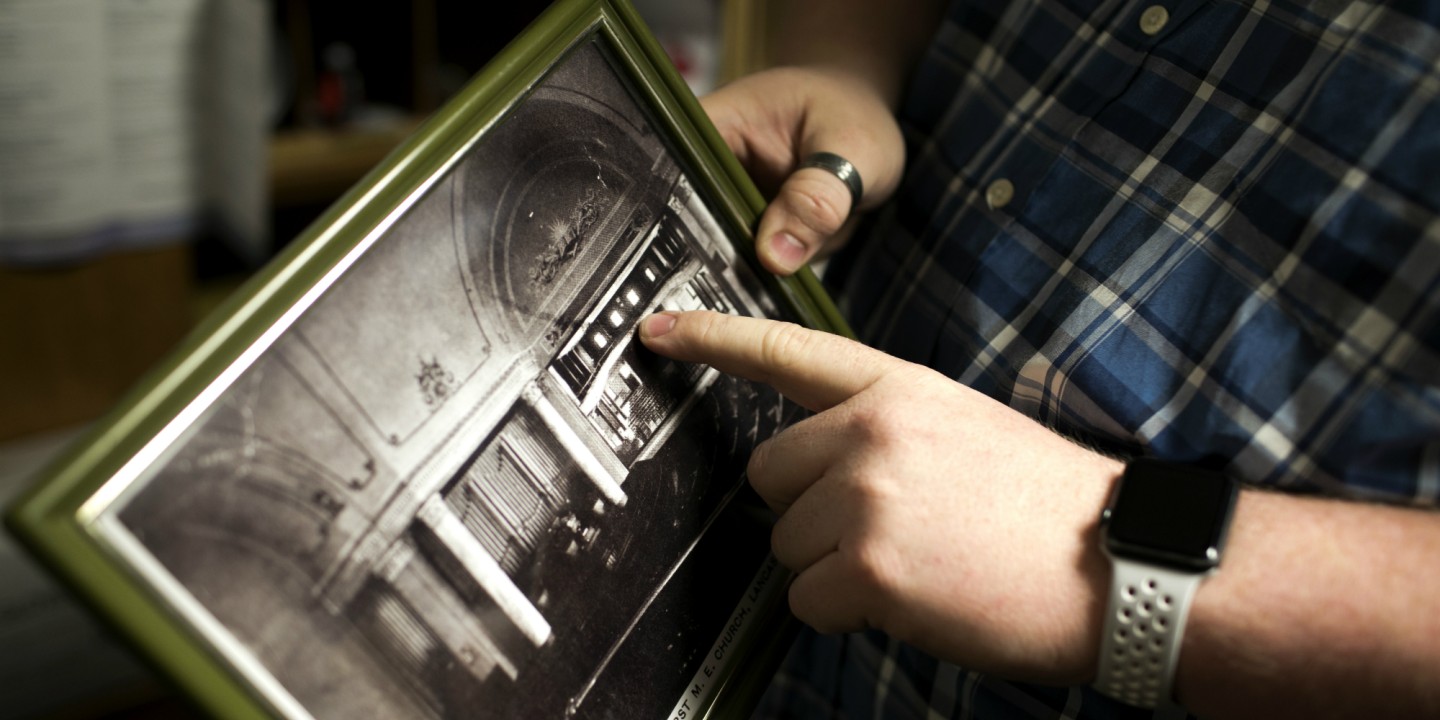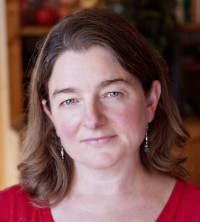
"This is the pew where my grandfather always sat,” said Joe Palmer as he led me on a tour of First United Methodist Church in Lancaster, Ohio, the church he grew up in and where he is now youth minister. Palmer recalled that his grandfather had a guide dog, Blossom, who would fall asleep during the service. “Her snores would vibrate the entire balcony.”
Palmer is only 28, but he is old enough to have watched Lancaster change dramatically in his lifetime. The city’s manufacturing center moved to Columbus, and the community has struggled to define itself in a postindustrial landscape.
Lancaster, a city of about 40,000, is the county seat of Fairfield County, located just south of Columbus, along the Hocking River. For most of the 20th century, Lancaster was an important glass manufacturing center. The Anchor Hocking Company, a major maker of Depression glass, helped make the city a thriving municipality, what journalist and Lancaster native Brian Alexander describes as an “all-American town.”
Read our latest issue or browse back issues.
In his recently published book about Lancaster, Glass House, Alexander writes that the drastic cutbacks at Anchor Hocking have prompted an identity crisis for the city as painful as that of a “devout religionist losing faith.” The city is plagued by “dislocation, disconnection, and alienation.” As economic certainties disintegrated, the city has lost its moderate conservatism, Alexander says. Some Lancaster residents have “retreated into the certainty of fundamentalist Christianity,” while others have drifted away from religion all together. Like other areas in the Midwest hit hard by the decline of manufacturing, Fairfield County turned out strongly for Donald Trump.
I went to Lancaster because I was curious about how church leaders were responding to the crisis that Alexander describes. It didn’t take long in talking with Palmer to realize that he did not fit Alexander’s depiction of dislocation and alienation. For one thing, he’s deeply committed to the city: he recently bought his grandfather’s house in town and he has no plans to leave. Furthermore, despite his deep roots in the church—and being a member of the largest confirmation class in the congregation’s history (36 in 2000)—he does not express much nostalgia for the way things used to be.
“Back then, Lancaster was very conservative, very Caucasian, with very little diversity,” he said, recalling his school days. “At Lancaster High School diversity was, shall we say, not well received. . . . It was not a welcoming community to outsiders.”
He believes that Lancaster has been and to some extent still is plagued by a desire to live inside a bubble, and he welcomes a different future. Among his students, he said, there are children who reach high school without ever leaving Fairfield County, not even to go to Columbus, just 35 miles away. “This is the world they know. Anything outside that norm is confusing and alarming, even threatening.”
Palmer thinks the church was one of the institutions that created and tried to sustain Lancaster as a protected bubble. The church of his childhood, he says, was too individualistic, and “it was all surface religion. We talked about working on your relationship with God, with Christ, but had few conversations about what was going on in the world.” The church of the past, he said, was where families of status and money displayed their civic conscience along with their wealth.
Palmer believes the church is better for the changes that have come to the city. “We just need to do God’s work,” he says. “We don’t need to worry about our status or our image. We just need to do.”
On that point, the church’s senior pastor, Brian Jones, agrees. “Churches that were able to survive and thrive amid the downfall of Anchor Hocking were those that understood the need to become missional. They could not expect to just open their doors and have the ‘right’ people show up anymore.”
Palmer is eager to help the youth at First United Methodist break out of the bubble. He helps them explore food deserts and issues of mental health and drug addiction, and he tries to help them see local realities in a bigger social context.
A surprising number of the people I met in Lancaster are like Joe Palmer and can trace their family history back for generations in the region and in their church communities. Just a few blocks north of First United Methodist, in the historically black section of Lancaster, is Allen Chapel, which is where I met the Saunders family. Evan Saunders, the youngest of eight children—all raised in Lancaster—is the pastor at Allen Chapel. The congregation was founded in 1825 as an African Methodist Episcopal church, but it now functions independently.
Saunders’s mother still lives in the neighborhood, and we waited for church to begin that Sunday until she and a nephew arrived.
“We are a spirit-led church,” Saunders joked with a twinkle in his eye. I wasn’t sure if the “spirit” for which we were waiting was the Holy Spirit or Saunders’s mother, a 96-year-old woman with a grin like her son’s.
Each of Saunders’s siblings, I found out, has a passionate story to tell about Lancaster and its history. Lancaster once boasted of being the whitest town in America, and racism was part of their everyday lives.
They remember the days when black people could swim in the public pool only one Friday a month—after which the pool was cleaned. Alan Saunders remembered not being allowed to stand next to any white girls in the school choir, and how his invitation to join the Junior Masons was rescinded when the group learned he was black. Hollie Saunders remembered being shoved against the lockers in high school after Martin Luther King Jr. was assassinated and that classmates raised their fists to signify white power.
Evan said that as the younger child, his experience was a bit different—he didn’t experience as much overt racism, and he did not feel as limited by race. But the racism is still there, he said.
“It is coming back,” declared Alan. “The ones that would hide it, saying it behind your back, are bold enough now to say it.”
Hollie agreed. “Now you have Trump saying, ‘Make America great again,’ which we say means, ‘Make America white again.’”
In his book, Alexander suggests that for decades the people of Lancaster believed that any struggles the city was having could be blamed on outsiders. If Anchor Hocking was going through a hard time, it was because Chinese and Mexican workers were driving down wages. If there was a drug problem in town, it was because drugs were coming in from Columbus. People didn’t want to consider that their problems might be caused by realities in the town itself. In talking to Hollie Saunders, I realized that she has no such illusions about the past or present. The racism that continues to live in Lancaster, she said, is “never going to go away.”
Yet members of the Saunders family have maintained ties to Lancaster, and they are both optimistic about the town’s future and committed to it. Besides being pastor at the church, Evan coaches youth football in the community. Hollie serves on the town historical commission and has written a book about the history of black people in Lancaster. “This is our town,” she said. “We need to take care of it. There is a core of people who have taken [this task] up themselves.”
Downtown Lancaster boasts a remodeled hotel and other revitalization efforts, along with a more controversial feature: a new jail. Some people don’t like the jail now being in the center of town. Evan Saunders, for example, complained: “The first thing you see when you pull into town is a huge, nice sheriff’s building. Across the street, a nice halfway house.” Saunders and others who mentioned the jail to me think that it is a painful symbol of the emerging Lancaster, a place whose economy is thriving mostly in the social service sector and where social problems are front and center.
But Palmer disagrees. He thinks the jail’s location makes sense, since downtown is on the bus route and it’s where the social service agencies are. “The people who are visiting [the jail] . . . can get down here easily, see their loved ones, get help that they need.” He sees some hypocrisy in residents who want to hide the town’s social problems. The debate over the jail is a version of the larger debate over Lancaster’s identity and future.
Mainline Christianity continues to have a formidable presence in Lancaster. The 13-block historic district includes three Methodist churches, three Lutheran churches, a Presbyterian church, an Episcopal church, and a Catholic church, along with several independent and nondenominational churches—all still active.
One of the churches in the historic downtown is St. Peter’s Lutheran Church. Originally a German-speaking congregation, it gave birth to two other Lutheran churches, First English Lutheran Church, a few blocks away, and Emmanuel Lutheran, a few blocks in the other direction. St. Peter’s own commitment to its future in Lancaster is evident in the scaffolding on the building, part of a reconstruction of the church’s massive steeple. The congregation raised money for nine years to make it happen.
The worries at St. Peter’s resemble those at most mainline churches. Pastor Diane Schwiger-Alexander, the interim minister, wants to see more young parents involved in the church and not just dropping their kids off for programs. And she’d like to see older people sharing their faith stories with younger generations. She notes that the traditional pattern of young adults returning to church after getting married and having children is not happening anymore, and she’s not optimistic that that trend will shift.
Pastor Schwiger-Alexander and the congregation are aware that three downtown Lutheran churches, as well as the four other Lutheran churches in the area, need to think about working together. None of the congregations is ready to give up its building, but they are meeting together to explore how they might share ministry and perhaps even resources and staff.
Another downtown church, St. John’s Episcopal, is led by Bill Pursley, who also has deep roots in the area. He lives outside the city, where he has gardens, a barn, a pasture, a summer kitchen for canning, and a root cellar. Lately, he has taken up beekeeping.
Father Bill said he understands the nostalgia that some in the older generations feel for life as it was in Lancaster, but he doesn’t entirely share it. He remembers the days when the vestry was made up of executives from Anchor Hocking and other corporations, and how they exercised “very top-down leadership styles, and they yelled a lot.” Vestry meetings, he said, have gotten a whole lot easier. “We’ve got a consensus model now, and it works great. But back in the old days, you thought they would come to blows over an expenditure in the building fund.”
Father Bill believes that people can find a proper orientation to the past, one that honors the heritage and the people who built it while looking forward. On Rogation Sunday, with rain pouring down and plans to go outside to bless the church garden put on hold, Father Bill leads the congregation through Rite I of the Book of Common Prayer. The acolytes wear white robes and white gloves. I can see a soccer jersey under one of the boy’s robes. The church is a mix, Father Bill said, of young and old, liberal and conservative. He appreciates the spectrum of views possible within a mainline community, and he wants to avoid divisions in the church that create winners and losers.
Father Bill is trying to prepare the congregation for a different kind of model of church life than what it has known. He said the church is moving toward being “family-sized” instead of “corporate-sized,” with fewer professionals and more volunteers, more sharing and less owning. He shares preaching responsibilities at St. John’s (and at another Episcopal church nearby) with a deacon and a layperson. He sees hopeful signs of St. John’s being a community that works together, has open doors, and a “flexibility that bodes well for the future.”
Palmer shows me the site of the Anchor Hocking factory. Like many in Lancaster, he tends to refer to Anchor Hocking in the past tense, even though it continues to operate at a reduced level. The neighborhood here is packed with small homes on narrow streets. Some of them are well kept, but others are dilapidated. I note several Confederate flags.
I asked Palmer about whether drug abuse has plagued Lancaster, as it has many small towns—an issue Brian Alexander cites in his book. Disagreeing with Alexander, Palmer said that he doesn’t think the problem can be blamed on the departure of Anchor Hocking and the new economic realities Lancaster is facing. “Yes, the heroin is bad out here,” said Palmer, “but it is bad everywhere. . . . We rose in opiate use as much as any of the towns in Ohio. I think there was a correlation, but not necessarily causation.”
When I asked Palmer about the future of Lancaster, he acknowledged that much remains unknown but expressed his sense of responsibility for that future. “OK, Anchor Hocking is closed. What are you going to do about it? OK, there is an opioid epidemic. What are you going to do about it? . . . This is our community. What can we do?”
“We were Anchor Hocking,” he says. “That was our identity. Now we are not Anchor Hocking. We are Lancaster.”
Palmer thinks his congregation understands the new realities facing church and community. He notes that First United Methodist has built a campus on the Anchor Hocking side of town with an emphasis on reaching children and youth. The congregation wants to work with and for the community. But the identity of the community remains an open question. “We are not rural. We are not urban. We are not suburban. What are we?”
There is no question that economic and social changes have challenged Lancaster’s idea of itself. The days of the all-American town are gone. But people like Joe Palmer and the Saunders family are aware that the past days were not entirely golden ones. The faith of the people I met, and their commitment to their institutions and to the community, has not been radically undermined by the decline of Anchor Hocking. They see resources in the community that go far beyond manufacturing, and they are investing themselves in their congregations, their neighbors, and their city.
A version of this article appears in the November 8 print edition under the title “After the glass factory.”







